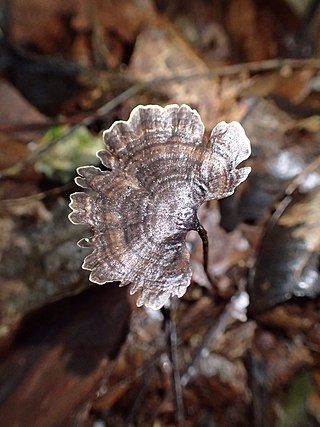Related Research Articles

Antrodiella is a genus of fungi in the family Steccherinaceae of the order Polyporales.

Favolus, or honeycomb fungus, is a genus of fungi in the family Polyporaceae. The fruit bodies of Favolus species are fleshy with radially arranged pores on the underside of the cap that are angular and deeply pitted, somewhat resembling a honeycomb.

Lignosus is a genus of polypore fungi in the family Polyporaceae. The genus was circumscribed in 1920 by mycologists Curtis Gates Lloyd and Camille Torrend, with L. sacer as the type species.

Skeletocutis is a genus of about 40 species of poroid fungi in the family Polyporaceae. The genus has a cosmopolitan distribution, although most species are found in the Northern Hemisphere. It causes a white rot in a diverse array of woody substrates, and the fruit bodies grow as a crust on the surface of the decaying wood. Sometimes the edges of the crust are turned outward to form rudimentary bracket-like caps.

Tyromyces is a genus of poroid fungi in the family Polyporaceae. It was circumscribed by mycologist Petter Karsten in 1881. The type species is the widely distributed Tyromyces chioneus, commonly known as the white cheese polypore. The phylogenetic position of Tyromyces within the Polyporales is uncertain, but it appears that it does not belong to the "core polyporoid clade". Tyromyces is polyphyletic as it is currently circumscribed, and has been described as "a dumping place for monomitic white-rot species with thin-walled spores."
Skeletocutis africana is a species of poroid crust fungus in the family Polyporaceae. Described as new to science in 2006 by mycologists Leif Ryvarden and Peter Roberts, the fungus is found in Cameroon, where it grows on logs in tropical lowland rainforest environments. The type collection was made in Korup National Park, in South West Province.
Skeletocutis bambusicola is a species of poroid crust fungus in the family Polyporaceae. It was described as new to science in 2012 by mycologists Li-Wei Zhou and Wen-Min Qin. It is found in southern China, where it grows on dead bamboo. The type collection was made in Mengla County, Yunnan Province. The specific epithet bambusicola refers to its growth on bamboo. At the time of publication, S. bambusicola was the 22nd Skeletocutis species recorded from China.
Skeletocutis borealis is a rare species of poroid fungus in the family Polyporaceae. Found in northern Europe, it was described as new to science in 1998 by Finnish mycologist Tuomo Niemelä.
Skeletocutis brevispora is a species of poroid crust fungus in the family Polyporaceae. It was described as new to science in 1998 by Finnish mycologist Tuomo Niemelä.
Skeletocutis yunnanensis is a species of poroid crust fungus in the family Polyporaceae that was described as a new species in 2016. The type specimen was collected in northern Yunnan Province, southwestern China, where it was found growing on decaying angiosperm wood in a temperate forest.
Dichomitus eucalypti is a crust fungus that was described as a new species in 1985 by Norwegian mycologist Leif Ryvarden. The fruit body of the fungus measures 1–2 cm in diameter, and has a white to pale cream pore surface with small round pores numbering 2–3 per millimetre. D. eucalypti has a dimitic hyphal structure, containing both generative and binding hyphae. Generative hyphae are thin walled with clamps, and measure 2.5–4 μm in diameter. Found in the context, the binding hyphae are solid, hyaline, and measure 2–5 μm. Spores are more or less cylindrical, thin-walled and hyaline, and have dimensions of 7–8.5 by 3–4 μm.

Loweomyces fractipes is a species of poroid fungus in the family Steccherinaceae, and the type species of the genus Loweomyces. It is a widely distributed species, found in North America, Europe, Central America, South America, and Korea.
Yuchengia is a fungal genus in the family Polyporaceae. It is a monotypic genus, containing the single species Yuchengia narymica, a crust fungus formerly placed in the genus Perenniporia and originally described as Trametes narymica by Czech mycologist Albert Pilát.
Leifiporia is a genus of two species of poroid white rot crust fungi in the family Polyporaceae. The genus was circumscribed by Chinese mycologists in 2016 to accommodate the type species Leifiporia rhizomorpha.
Antella niemelaei is a species of poroid crust fungus in the family Steccherinaceae.
Grammothele bambusicola is a poroid crust fungus in the family Polyporaceae that is found in Asia. It was described as new to science in 1984 by Norwegian mycologist Leif Ryvarden.
Skeletocutis niveicolor is a species of poroid crust fungus in the family Polyporaceae. It was first described in 1920 by American mycologist William Alphonso Murrill as Poria niveicolor. The type was collected on well-rotted wood found in Cockpit Country, Jamaica in 1909. Leif Ryvarden transferred it to the genus Skeletocutis in 1985. He noted that it was readily distinguished from other Skeletocutis species by its small spores, which measure 2.5–3.1 by 1.5–2 μm. In addition to Jamaica, the fungus has been also reported from Argentina and Costa Rica.
Skeletocutis stramentica is a species of poroid fungus in the family Polyporaceae that is found in New Zealand.

Perenniporia stipitata is a species of poroid fungus in the family Polyporaceae. Found in Brazil, it was described as a new species in 1987 by Norwegian mycologist Leif Ryvarden.
Vanderbylia vicina is a species of poroid fungus in the family Polyporaceae, and the type species of the genus Vanderbylia.